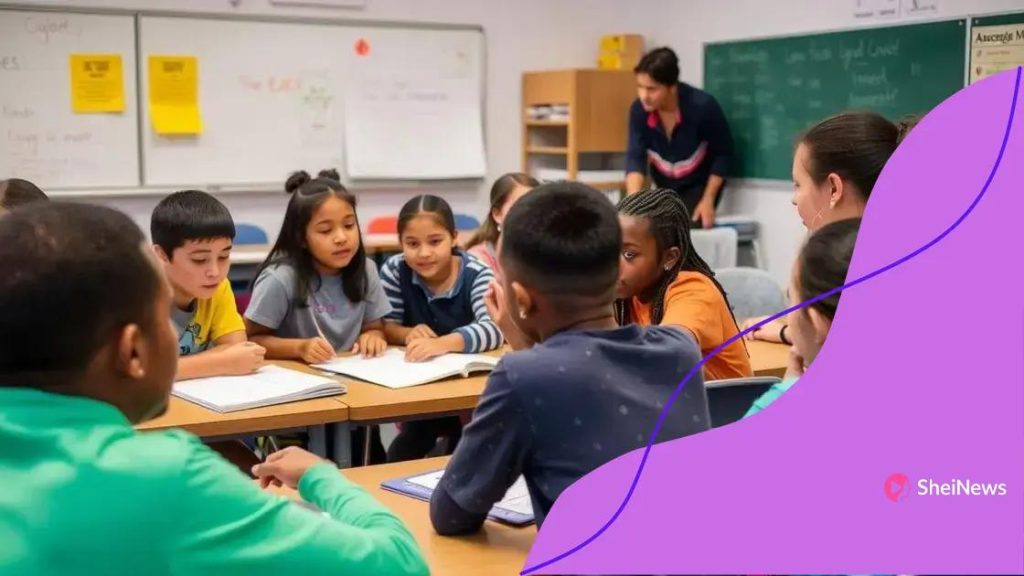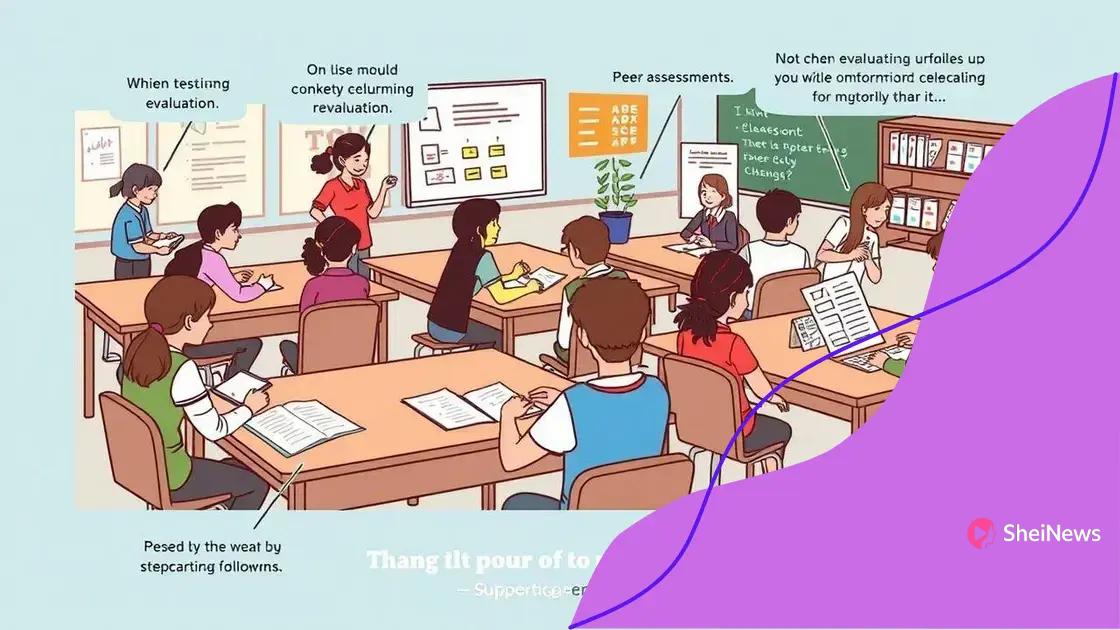Holistic assessment of student progress: a guide for educators

Anúncios
Holistic assessment of student progress evaluates multiple skills beyond academics, fostering engagement, personal growth, and informed teaching strategies through diverse evaluation methods and continuous feedback.
Holistic assessment of student progress is transforming the way we view education. Have you ever wondered how a comprehensive approach can reveal a student’s true potential? This article dives into the intricacies of this assessment method, offering insights for educators.
Anúncios
Understanding holistic assessment methods
Understanding holistic assessment methods requires a solid grasp of various strategies used to evaluate student development comprehensively. These methods transcend traditional testing by focusing on a student’s overall learning experience.
Instead of just measuring what students know, holistic assessments consider their skills, attitudes, and even creativity. This approach provides a fuller picture of a student’s abilities, which is crucial for effective teaching.
Key Features of Holistic Assessment
When employing holistic assessment methods, several key features come into play. Educators should pay attention to:
Anúncios
- Multiple assessment formats, such as projects, presentations, and portfolios.
- Involvement of self-assessment and peer feedback to promote active learning.
- The importance of a positive learning environment that encourages student expression.
- Consideration of personal and emotional growth alongside academic achievement.
Integrating these features into teaching practices helps create a balanced evaluation strategy. This strategy not only enhances student engagement but also fosters deeper understanding. For instance, a project-based assessment allows students to showcase their strengths in unique ways.
Benefits of Holistic Assessment Methods
The advantages of adopting holistic assessment methods are significant. They provide richer feedback for students, helping them identify both strengths and areas for improvement. Teachers can also tailor their instruction based on a comprehensive view of each student. Moreover, holistic assessments often lead to improved motivation, as students see their efforts recognized beyond mere test scores.
In conclusion, understanding and implementing holistic assessment methods can positively impact educators and students alike. By prioritizing a well-rounded view of student progress, schools can create a more effective learning environment.
Benefits of holistic assessment in education
Benefits of holistic assessment in education are numerous and impactful for both students and educators. This approach recognizes that learning is multifaceted and should be evaluated from various angles.
One of the main advantages of holistic assessment is that it provides a more complete view of a student’s abilities. Instead of relying solely on standardized tests, educators can gain insights into a student’s strengths, weaknesses, and overall development.
Promoting Active Engagement
Holistic assessments often encourage students to engage more actively in their learning process. This can lead to:
- Increased motivation as students see their progress in various areas.
- Enhanced critical thinking skills through project-based evaluations.
- A deeper understanding of the material as students connect concepts.
- Greater opportunities for self-expression and creativity in their work.
Incorporating these elements into education fosters a love for learning. When students are aware that their unique skills are valued, they are more inclined to participate and take risks.
Better Feedback for Improvement
Another significant benefit is that holistic assessments provide richer feedback. Students receive specific responses rather than just a numerical score, which helps them understand their learning goals. Teachers can tailor instruction based on these insights, creating a more personalized learning experience.
Additionally, holistic assessments include peer feedback and self-assessment components, allowing students to reflect on their performance critically. This process not only promotes responsibility but also accountability in their learning journey.
Overall, the enhanced feedback loop created by holistic assessment methods supports continuous improvement for students, helping them strive towards their educational goals.
Key components of effective student evaluations

Key components of effective student evaluations help educators assess student learning in ways that go beyond traditional testing. These components ensure that evaluations are comprehensive and reflective of a student’s true abilities.
One important aspect is the use of multiple assessment types. This variety can include tests, portfolios, projects, and presentations, allowing for a broader view of each student’s skills. The combination of these methods caters to different learning styles and helps to illustrate how students express their knowledge.
Standards and Objectives
Effective evaluations must align with clear learning standards and objectives. When assessments are designed with specific goals in mind, students have a clear understanding of what is expected of them. This clarity improves their focus and motivation to meet those expectations. Furthermore, aligning evaluations with objectives promotes consistency in grading and feedback.
Inclusivity and Fairness
Another crucial component is ensuring that evaluations are inclusive and fair. All students should have equal opportunities to demonstrate their knowledge and skills. Considerations for linguistic diversity, special needs, and cultural differences should be integral to assessment design. By creating accommodations where necessary, educators provide a more accurate gauge of student progress.
Feedback is also essential in effective evaluations. Instead of just offering a grade, detailed comments about a student’s performance help guide their learning path. Constructive feedback enables students to recognize their strengths and areas needing improvement, fostering a growth mindset.
Additionally, involving students in the evaluation process through self-assessments and peer reviews promotes accountability. When students reflect on their learning, it encourages them to take ownership of their progress.
Overall, understanding and incorporating these key components into student evaluations enhances the educational experience, leading to more informed teaching practices and improved student outcomes.
Strategies for implementing holistic assessments
Strategies for implementing holistic assessments are vital for educators who want to understand their students better. These strategies not only enhance teaching methods but also improve student engagement and learning outcomes.
One effective strategy is integrating formative assessments into the classroom routine. By using assessments like quizzes, peer evaluations, and class discussions, teachers can gauge student understanding in real-time. This allows for immediate feedback, which is crucial for growth.
Creating Diverse Assessment Opportunities
Another key strategy involves providing diverse assessment formats. Utilizing portfolios, group projects, and self-assessments gives students various ways to demonstrate their learning. Each format appeals to different strengths, allowing students to showcase their skills uniquely.
- Portfolios allow students to collect and reflect on their best work over time.
- Group projects foster teamwork and collaboration among students.
- Self-assessments encourage personal reflection and responsibility for learning.
- Performance tasks help measure real-world application of knowledge.
Implementing these strategies requires careful planning and communication. Teachers should clearly explain the purpose of each assessment method to students. This helps them understand how each strategy contributes to their learning journey.
Involving Students in the Assessment Process
Involving students in their own assessment process is also effective. Provide opportunities for them to set goals and identify their learning objectives. When students have a say in their assessments, they become more invested in their education.
Additionally, using technology can simplify the implementation of holistic assessments. Tools like online quizzes, learning management systems, and digital portfolios can streamline the evaluation process. By making assessments more accessible, teachers can gather valuable insights into student progress.
Ultimately, the goal of these strategies is to create a supportive environment that values the whole child. Educators who successfully implement holistic assessments can foster a deeper connection with their students and promote a lifelong love of learning.
Measuring the impact of holistic evaluations
Measuring the impact of holistic evaluations is essential for understanding their effectiveness in the classroom. By assessing student progress through various methods, educators can gather valuable data regarding learning outcomes.
One way to measure the impact is by analyzing student improvement over time. By tracking performance in multiple areas, teachers can see growth not only in academic skills but also in social and emotional development. This holistic view allows educators to pinpoint what works and where adjustments are needed.
Collecting Data Effectively
Data collection is vital for evaluating the impact of holistic assessments. Educators should utilize various tools like:
- Surveys and feedback forms to gather students’ perspectives on their learning experience.
- Standardized test scores to compare with holistic measures.
- Classroom observations to note student engagement and participation.
- Portfolios that illustrate student work over time for qualitative analysis.
Combining quantitative and qualitative data provides a comprehensive picture of a student’s progress. This data helps inform instructional decisions and curriculum adjustments to better serve students.
Evaluating Student Engagement
Another essential aspect of measuring impact is assessing student engagement. Active participation in their own learning indicates that students are benefiting from holistic evaluations. Classroom discussions, collaborative projects, and self-assessments can be indicators of this engagement. The more involved students are, the more likely they are to retain information and develop critical skills.
Additionally, educators can conduct periodic check-ins with students to understand their feelings about the assessment methods. This feedback loop ensures that evaluations remain student-centered and responsive to their needs.
Ultimately, measuring the impact of holistic evaluations requires a commitment to continuous improvement. By regularly reviewing data and seeking feedback, educators can refine their practices to create a more effective and supportive learning environment.
FAQ – Frequently Asked Questions about Holistic Assessments in Education
What are holistic assessments?
Holistic assessments evaluate student learning by considering multiple skills and abilities, providing a comprehensive view of their progress.
How do holistic evaluations benefit students?
They engage students by allowing for diverse forms of expression and learning, fostering motivation and personal growth.
What methods are used in holistic assessments?
Methods can include portfolios, peer reviews, self-assessments, and project-based evaluations, among others.
How can we measure the impact of holistic evaluations?
Impact can be measured through student improvement, feedback, engagement levels, and data collection over time.





